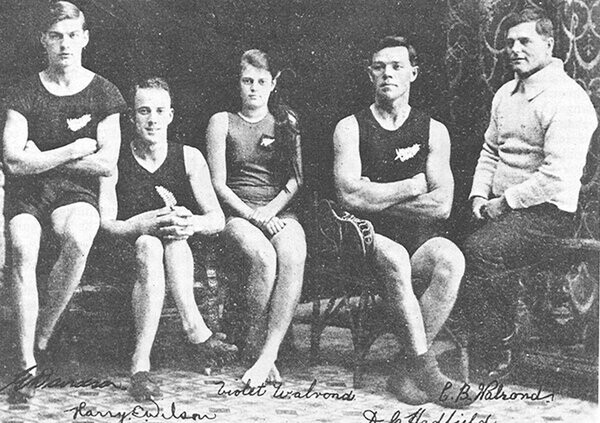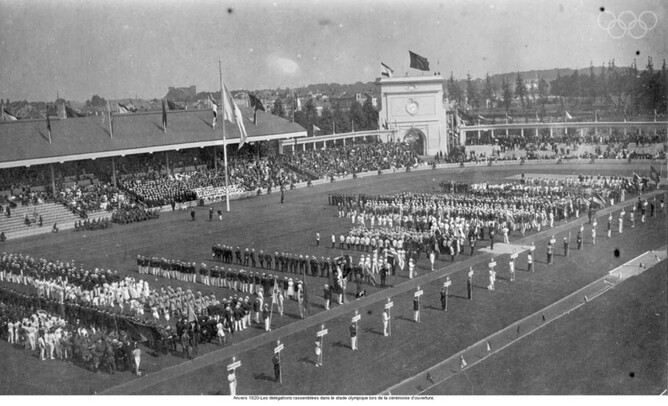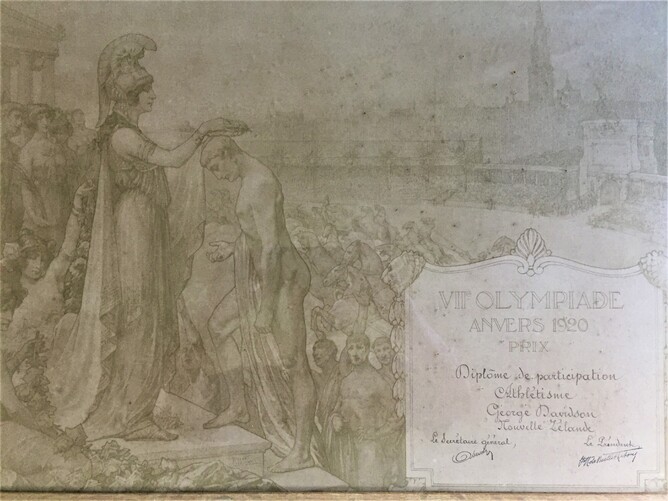Written by Elaine Mead - Every four years the agony and the ecstasy of sporting dreams are played out before the watching world and I reflect on my family connection to New Zealand Olympics.
The 1916 Summer Olympics, which were to have been held in Berlin, were cancelled due to World War One. When the Olympic Games resumed after the war, Antwerp was awarded hosting of the 1920 Summer Games as a tribute to the Belgian people.
Previously, New Zealand sportsmen competed as part of an Australasian team but this was the first time a team marched under the New Zealand flag, and my great-uncle, George Davidson, was one of them.
The four athletes were the first New Zealand Olympic team and the first to compete in black singlets with the silver fern emblem hand-sewn over their hearts. In the photo above from left to right, George Davidson (sprinter); Harry Wilson (hurdler); Violet Walrond (swimmer); Darcy Hadfield (rower) and Cecil (aka ‘Tui’) Walrond.
Violet was the first New Zealand female Olympian and only fifteen years of age at the time; she is still our youngest Olympic competitor to date. She was only allowed to travel and compete if chaperoned and so her father, Cecil Walrond, accompanied the team as its unofficial coach.
The current Olympics were to be held in 2020, when it would have been a centennial celebration of New Zealand Olympic teams. However, the global impact of COVID-19 interfered with plans and preparation. The 1920 team experienced their own difficulties in preparation in equally trying global circumstances. The Olympic Games were held only two years after the end of World War One and the ensuing Spanish Influenza (commonly referred to as the Spanish Flu Pandemic).
To get to Belgium, the team travelled from Auckland to Wellington by train, then sailed on the Manuka to Sydney, where they boarded the liner Euripides. But the ship was held up for six days in Melbourne and also delayed at Durban. Training facilities on board ship were limited and they arrived after nine weeks and five days of travelling – only a couple of days before the opening ceremony on 14 August.
Despite this, all four members of the team made a final - the only one in New Zealand’s Olympic history to do so and a feat unlikely to be equalled again.
Walrond made the finals of both the 100m and 300m freestyle, finishing fifth in the former and unable to compete in the 300m due to illness. The pool for the Olympic swimming competition was a fenced-off part of a chilly, murky canal, with no lane ropes. A likely source of her illness.
Both Harry Wilson (aged twenty-four) and Darcy Hadfield (aged thirty-one) served overseas during World War One, with Hadfield wounded in the head by shrapnel at Passchendaele and hospitalised until after the war. They both competed at international meets whilst in service and afterwards. Wilson was the team flag bearer at the opening ceremony and finished fourth in the 110-metre hurdles in which the winner set a world record. Hadfield was the only medal winner, achieving bronze in the men’s single sculls over 2000-metres, held on the Brussels–Scheldt Maritime Canal. The winner of that event was John B Kelly Snr, father of actress Grace Kelly.
George (aged twenty-two) had grown up playing rugby league with brothers and using his speed to good effect on the wing. At the Olympics, he was eliminated in the quarter finals of the 100-metres but in the 200-metre event his time continually improved through his heats. He was even faster than British runner, Harold Abrahams whose battle with American runners Jackson Scholz and Charley Paddock was immortalised in the movie, Chariots of Fire’ In the final he ran his best time of 22.3, finishing fifth in a field which included Charley Paddock.
I often wonder what George would have felt, finding himself on the continent where only three years earlier his eldest brother, Charles, had lost his life. We don’t know if he visited his brother’s grave but he did send several postcards to his young sister at home and brought back a container painted with a typical Belgian scene, which now sits on my mother’s sideboard.
No doubt, like his team members at the time and those currently competing in Tokyo for themselves and their country – it was indeed a mix of agony and ecstasy.
We are so fortunate to have this important piece of family history recorded.
Sources:



